Frederic Etiemble's Blog
June 11, 2020
Lessons from Hilti on What it Takes to Shift from a Product to a Service Business Model
 Source: Strategyzer
Source: StrategyzerIn a previous post, we explained how business model patterns can help executives shift from outdated to a more competitive business model. Today we illustrate one of the patterns, the shift from product to service, with Hilti. And we go behind-the-scenes with Dr. Christoph Loos, CEO of Hilti, to understand what it takes to lead such a business transformation.
In the early 2000s, tool manufacturer Hilti shifts from selling high-quality tools to selling tool fleet management services to construction companies, after a key customer requests a holistic tool management system to increase productivity.
It’s a beautiful case illustrating the “from product to service” shift with a happy ending. CEO of Hilti Dr. Christoph Loos explains how this transformation helped his company withstand the test of the 2008 Global Financial Crisis. At a time when the whole construction industry came to an abrupt standstill.
In our research for The Invincible Company, we interviewed Dr. Christoph Loos and discussed this shift from the CEO’s perspective.
 Source: The Invincible Company by Strategyzer
Source: The Invincible Company by StrategyzerDr. Christoph Loos shared the “biggest challenge was getting our sales force behind this shift. They were used to demonstrating and selling single tools to tool crib managers or project leaders on the job site. And now they had to learn a much longer sales cycle of a conceptual sale to the executive level of our customers that they usually didn’t have access to. This shift took us many years.”
Dr. Loos described other key challenges as:
“We also struggled with many operational challenges in capturing the new contractual obligations in our IT systems (ensuring fleet customers wouldn’t be charged for repair costs, tool pick-ups and deliveries)”
“Out of a finance perspective, it’s easier to sell a tool and to get your money after 30 days than delivering a few hundred tools to a customer and receiving monthly installments over 4 years while piling up receivables on your balance sheet.”
When the time to shift a business model comes, leaders always face a challenging endeavor. They need to continue to operate the expiring business while simultaneously exploring the shift to a new, competitive one. We asked Dr. Loos how he managed to overcome these challenges. He pointed out “a very strong alignment of the executive team at Hilti and staying the course despite internal resistance over a long time period (>15 years). And to allow enough time for the required change management to take hold by scaling it up step-by-step, country-by-country. The approach in each new country to generate initial successes, typically with customers with strong ties to Hilti, with strong senior management involvement and our best sales team members. Their initial success was then used to inspire the rest of the team.”
A business transformation is always a challenging endeavor. Still, before your business model expires, we hope you’ll find inspiration in the Hilti shift to renovate your existing business model to a new, more competitive one.
There are 12 shift patterns in The Invincible Company to inspire your next business model shift.
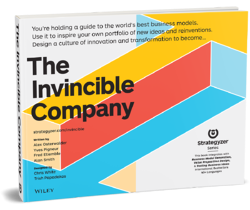
You can find this example and many others in our latest book
The Invincible Company
Originally published at https://www.strategyzer.com .

Lessons from Hilti on What it Takes to Shift from a Product to a Service Business Model was originally published in On innovation and business transformation on Medium, where people are continuing the conversation by highlighting and responding to this story.
April 27, 2020
How to Use Patterns to Shift an Outdated Business Model to a More Competitive One
 Source: Strategyzer
Source: StrategyzerIn a previous post, we explained how business model patterns help entrepreneurs and business leaders go beyond the traditional means of competing on product, service, technology or price. Ultimately, create better, more resilient businesses. But no business model can live forever. Today we show how business model patterns can help executives and innovation teams think through how to substantially improve your current business model by shifting it from a less competitive to a more competitive one.
What got you here today, won’t get you there tomorrow. When the time to renovate a business model comes, leaders face a challenging endeavor. They need to continue to operate the expiring business while simultaneously exploring the shift to a new, competitive one. In The Invincible Company, we codify 12 different SHIFT patterns. Each pattern helps you think through how you could substantially improve your existing business model. Leaders and appointed transformation teams can use the Shift Patterns Library as inspiration. Along with rigorous testing to reduce risk and uncertainty, the Shift Patterns can help you shift your existing business to a more competitive iteration.
SHIFT Patterns Library
We designed a library of 12 business model shift patterns to help you explore how to shift from an old to a new business model. Like invent patterns, the shift patterns serve as a reference library or inspiration to help you build a business model on top of an existing one.
One of the more obvious patterns is the shift from Product to Recurring Service. It illustrates how a company can shift from manufacturing (and/or buying) and selling products toward providing a recurring service. This shift can help a company get more predictable revenues that grow exponentially because you build on top of a continuously growing base of customers. The shift is shown in the image below.
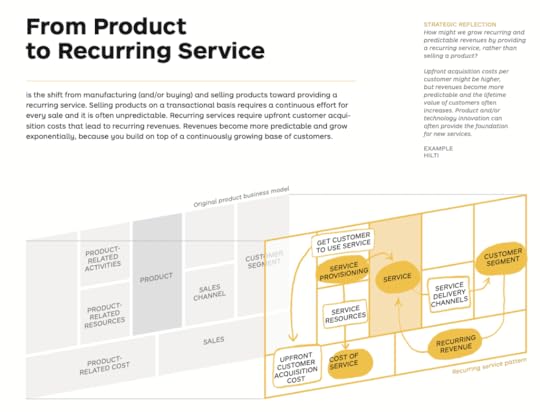 Source: The Invincible Company by Strategyzer
Source: The Invincible Company by StrategyzerIn the next blog post, we will illustrate the Product to Service SHIFT with the Hilti case. And we will go behind-the-scenes with Dr. Christoph Loos, CEO of Hilti, to understand what it takes to lead and successfully execute such an overhaul of their business model.
Want to know more about business model patterns? Order your copy book today using the link below.
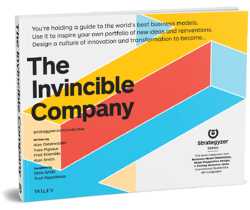
You can find this example and many others in our latest book
The Invincible Company
Originally published at https://www.strategyzer.com .

How to Use Patterns to Shift an Outdated Business Model to a More Competitive One was originally published in Notes from the innovation and transformation fields on Medium, where people are continuing the conversation by highlighting and responding to this story.
April 15, 2020
How to use patterns to design business models that go beyond technology, product and price
 Source: Strategyzer
Source: StrategyzerA lot of startups and established companies are trying to compete on superior technology, products, services and price. They are stuck in a rat race. Yet, the world’s most successful companies compete on superior business models. These business models build on patterns, i.e. repeatable configurations of different business model building blocks to strengthen an organization’s overall business model. This is the secret formula behind their success. Understanding those patterns helps entrepreneurs and business leaders create better, more resilient businesses.
A pattern is an arrangement of various elements to create a certain outcome. Architects, for instance, use a pattern when they associate large windows facing south in a living area to bring in lots of light. In mountainous areas, they might build on a different pattern, with larger walls and smaller windows to better conserve heat in winter. Architects use certain patterns over and over again because they lead to superior outcomes.
The same thinking can be applied to the business world. Yet, business model patterns are still underused today. A lot of companies focus on one or two elements of a business model, and not on all the building blocks and their potential configurations. The most popular elements they focus on are product, service, technology or price.
Many companies struggle with business model thinking. It will remain difficult for them to design superior business models. Unless they can access a good collection of business model patterns. That’s why we have developed a library of business model patterns. Entrepreneurs and business leaders can draw inspiration from those patterns, and build on them.
INVENT PatternsINVENT patterns help entrepreneurs and corporate innovation teams design better business models for their new ventures. For example, the business model blocks are configured to radically change how a company can reach and acquire a large number of customers in the Channel Kings pattern displayed below.
 Source: The Invincible Company by Strategyzer
Source: The Invincible Company by StrategyzerIn The Invincible Company, we codify 9 different INVENT patterns and 27 flavors. We show each pattern as a repeatable configuration of different business model building blocks that strengthen an organization’s overall business model. Each pattern helps you go beyond the traditional means of competition on product, service, technology or price. Each pattern helps you focus on a different way to achieve a superior business model.
 Source: The Invincible Company by Strategyzer
Source: The Invincible Company by StrategyzerIn a next blog post we will introduce the SHIFT patterns that help established companies shift from an outdated to a more competitive business model.
Want to know more about business model patterns? Order our book today.
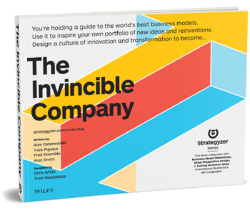
Out Now!
Originally published at https://www.strategyzer.com .

How to use patterns to design business models that go beyond technology, product and price was originally published in Notes from the innovation and transformation fields on Medium, where people are continuing the conversation by highlighting and responding to this story.
April 1, 2020
How Do You Know If Your Business Is At Risk Of Disruption?
 Source: Strategyzer
Source: StrategyzerOver the last weeks the coronavirus disrupted the entire global economy and almost every business on the face of the planet. Yet, Covid-19 is a black swan and a once in a century event. When things get back to normal (yes, it will take quite some time), companies need to prepare for more common types of disruption. In this blogpost, we explain how you can systematically assess the risk of disruption with our Disruption Assessment Tool.
Even before the coronavirus outbreak in December 2019, disruption was a big concern to executives. A 2016 McKinsey study shows that 80% of executives think their business model is at risk. More recent studies indicate the same.
From our experience working with clients, we see that while the concern is real, most executives can’t accurately forecast how seriously their business model is at risk. That is why we developed the Portfolio Map, a new strategic management tool we’re introducing in our upcoming book, The Invincible Company. It helps make the risk of disruption of explicit.
 Source: The Invincible Company, Strategyzer
Source: The Invincible Company, StrategyzerThe Research and Design Challenge
In the book, we show how you can assess the disruption risk of an existing business, so that you can place it on the right spot in the Portfolio Map. Let me explain how we developed the assessment framework.
Yves Pigneur pointed me to the most interesting research he had seen on this topic: How to identify your enemies before they destroy you, by Rafii and Kampas. That inspired us to create the first prototypes of a tool to assess the disruption risk of a business model. After a few iterations we tested the tool with innovation coaches and clients. We were getting good feedback, but for us something was not yet clicking with this prototype. Until Yves gave us the insight that took us to the next level.
When assessing overall disruption risk, we were aggregating risks from two different time horizons: early signs of disruption already materializing in a business today, and future disruption risks. And that aggregation led to flawed results.
The Tool
To use an image, to assess risk more accurately you need to consider not one, but two waves of disruption. A first wave that is already hitting your business model. You can observe its impact with available data. A second, bigger wave on the horizon, that is likely to hit you. Its impact cannot yet be felt yet but it can be anticipated with careful observation of the business environment.
Most organisations already capture the data they need to measure the disruption wave that’s already upon them. The Performance Assessment questions help leaders make sense of this data and you can use it to assess immediate disruption risk as precisely as possible. An unexpected drop in customer base for instance would be an obvious manifestation of an immediate disruption risk that the company has to face.
 Source: The Invincible Company, Strategyzer
Source: The Invincible Company, StrategyzerIn a second step, you need to constantly monitor your business environment to anticipate and assess if a bigger wave of disruption is likely to hit you. The Trend Assessment questions can then help you anticipate that future disruption risks. For instance, if a new regulation is to be enforced in 18 months that will impact the operations of a business then a big disruption wave is probably going to hit that business in 18 months.
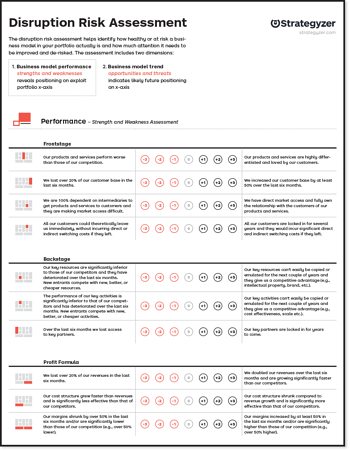 Source: The Invincible Company, Strategyzer
Source: The Invincible Company, StrategyzerIn summary the disruption risk assessment tool (click here to download it) uses close observation of current performance indicators and anticipation of future events in the business model environment, to help leaders assess the disruption risk of their business models. Once this disruption risk is made explicit and visible, leaders can more easily align on the most appropriate course of actions, set the right priorities and ultimately avoid those costly crises that a lack of anticipation leads to.
Caveat in the current context: I’m definitely not claiming that this tool has the magical power to warn your organization from a black swan event like Covid-19. It happened too fast. Yet, I’m convinced that leaders performing regular disruption risk assessment with this tool can at least have a head start. After all, we were already watching the news of the outbreak in Wuhan in December 2019. How many of us took actions then to improve and protect our business model(s) from that disruption threat in our business environment? When crises cannot be avoided, like the Covid-19 crisis, such a tool can at least help us enter the crisis better prepared.

You can find this tool and many others in our latest book The Invincible Company
Originally published at https://www.strategyzer.com .

How Do You Know If Your Business Is At Risk Of Disruption? was originally published in Notes from the innovation and transformation fields on Medium, where people are continuing the conversation by highlighting and responding to this story.
January 19, 2020
The books that most influenced my work in innovation and business transformation in 2019
 Photo by César Viteri on Unsplash
Photo by César Viteri on UnsplashI read many books and articles on business transformation and innovation as part of my research for The Invincible Company in 2019. Among the 30 books I read last year, not all were about business though. I have also read biographies, scientific and philosophy books. But I came across enough inspiring business books to continue the yearly sharing exercise I started in 2017. Again, it might not have the same sales impact as a recommendation from the Financial Times or Bill Gates but here are my four favourites business books from 2019, in no particular order.
“Read the best books first, or you may not have a chance to read them at all.” ― Henry David Thoreau
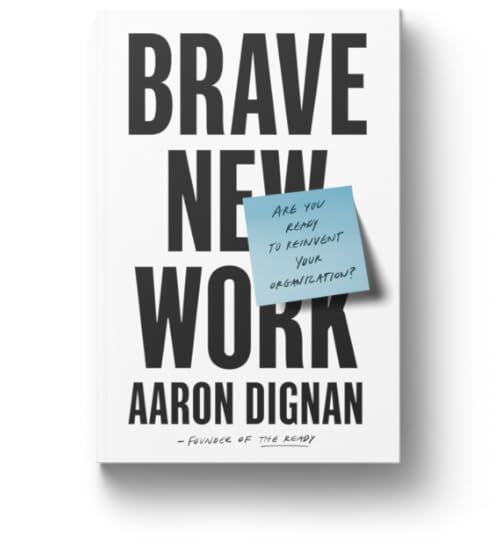
Brave New Work, by Aaron Dignan (2019).
Business transformation involves changing also the way we work. That’s both obvious and so hard. To complement my work in strategy and innovation, I keep an eye for books and publications that look into the challenges of business transformation via the organisational angle.
So I have been following Aaron Dignan and his company the Ready for a few years now. I have even used the OS canvas with clients on several occasions. So Brave new Work was a book I had been expecting. Building on his experience at the Ready, complemented by extensive research, Aaron Dignan provides a convincing synthesis of everything that’s broken with the way we work today, and of the many principles, techniques, and tools that inspiring pioneers are experimenting with to reinvent how we work. It’s my favourite book on this subject since Reinventing organizations by Frederic Laloux (2014).
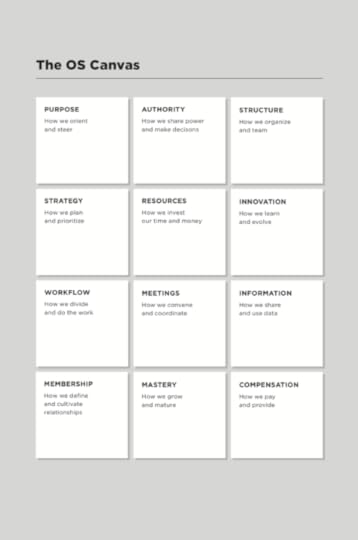 Source: The OS canvas by the Ready
Source: The OS canvas by the Ready“The problem isn’t our people. It’s not our leaders either. It’s our operating system.” ― Aaron Dignan

Blitzscaling by Reid Hoffman and Chris Yeh (2018)
Reid Hoffman and Chris Yeh define Blitzscaling as prioritizing speed over efficiency in the face of uncertainty. That book gave me great insights into how Silicon Valley successful entrepreneurs and thought leaders think about growth.
I’ve noticed that scaling is still a black box for many corporate clients I work with. Blitzscaling lifts the veil on this critical phase and some of the key enablers and blockers for growth.
 Source: FourWeekMBA.com
Source: FourWeekMBA.com“Great companies and great businesses often seem to be bad ideas when they first appear because business model innovations-by their very definition-can’t point to a proven business model to demonstrate why they’ll work.” ― Reid Hoffman

How to Reform Capitalism, by The School of Life (Alain de Botton).
This is a very short book that you can read within a couple of hours on a train or in a plane. It is full of insights into unattended human needs and how they could unlock the next evolution of capitalism.
This book already had an impact on my work as it is the inspiration for one of the techniques for better product & service innovation that Greg Bernarda (co-author of Value Proposition Design) and I incorporated in our strategy & innovation masterclasses. The below image is an illustration we use to show how identifying higher needs can lead to critical customer insights, here in the field of travel.
 Source: Strategyzer Masterclass
Source: Strategyzer Masterclass“What’s surprising is how unambitious consumer capitalism has, until now, been about many of the things that deliver higher sorts of satisfaction. Business has helped us to be warm, sage, and distracted. It has been markedly indifferent to our flourishing.” ― Alain de Botton
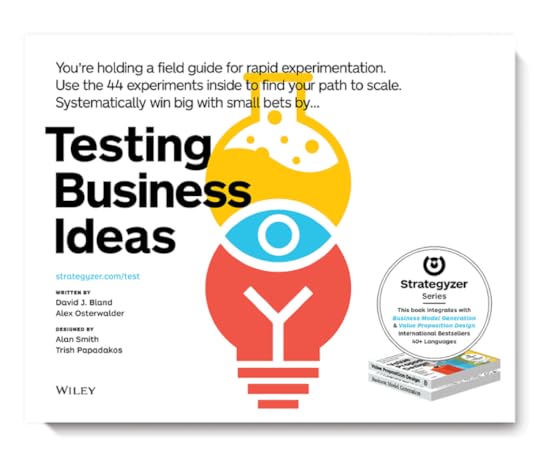
Testing Business Ideas, by David J. Bland and Alex Osterwalder (2019)
Full disclosure, I work with Strategyzer and I am currently involved in writing The Invincible Company, the next book by Alex Osterwalder. But I have not been involved at all in Testing Business Ideas and I discovered it in November 2019 like every other reader. When I opened the book, I felt the same joy I had felt when reading Business Model Generation and Value Proposition Design a few years before; the pleasure of reading a book where design and visuals contribute to making the learning experience both pleasant and easy.
On the content side, I think this extensive library of 44 experiments is a critical contribution to the field of innovation. The now widespread diffusion of design thinking concepts has made innovation leaders and teams more comfortable with designing and prototyping but most of them still lack solid testing knowledge and skills. They now have the guide to bridge that gap.
 Source: Testing Business Ideas, by David J. Bland and Alex Osterwalder
Source: Testing Business Ideas, by David J. Bland and Alex Osterwalder“Great teams are able to gain momentum and build up stronger evidence over time with a series of experiments” ― David J. Bland
That’s it for now! Hopefully those books are available at your local library, or easily downloadable on your smartphone/tablet.
The next business book on my reading list is Seeing Around Corners by Rita Mc Grath, another one that arrived at the end of 2019 that I am really looking forward to dive into. What’s next on your reading list?
Happy reading in 2020!
For those interested, my favourites from previous years:
The books that most influenced my work in innovation and business transformation in 2018
The books that most influenced my work in innovation and business transformation in 2017

The books that most influenced my work in innovation and business transformation in 2019 was originally published in Notes from the innovation and transformation fields on Medium, where people are continuing the conversation by highlighting and responding to this story.
December 2, 2019
Executive question: How to keep momentum after a Hack day?
I had a coffee chat last week with the Chief Information Officer (CIO) of an ASX100 manufacturing company. In a very traditional and process-driven organisation she wants her team to lead cross-functional innovation initiatives and has introduced hack days to initiate a spark. She was concerned about how to keep momentum after a hack day. So she approached me to draw on my experience of helping Global 500 companies create innovation ecosystems.
1. Objective
Wikipedia: a hackathon (also known as a hack day, hack fest or code fest) is a design sprint-like event in which computer programmers and others involved in software development, including graphic designers, interface designers, project managers, and others, often including domain experts, collaborate intensively on software projects.
In this company, she wants to use hack days as a way for her technology team to contribute to resolve problems experienced by employees or customers. Just the week before, she had organised and facilitated the first hack day.
It was a big success and three self-organised teams had formed on three different ideas that had picked up momentum throughout the day. Those three ideas were all efficiency innovation. They were about improving existing business processes, rather than exploring new products, services or businesses.
But even though they were still relatively close to current business they were also different enough for the team to be hesitant about the way to progress them further after the hack day. And as days passed by, she was growing worried that momentum and energy would be lost and that the hack day would lead to no tangible outcome.
She had a deep sense of opportunity for real change but felt she had to act quickly. I asked her what her real purpose was with these hack days. If she looked beyond her immediate need to support those three teams, what was the long-term objective? She acknowledged that delivering on those three ideas was not the end game.
“This is just the first step in a much longer journey to develop the ability to adapt and change as an organisation”, she said.
2. Innovation Readiness
With more clarity on the long-term objective we zoomed back on the immediate need.
“How ready is the organisation to support those three teams today? What can they piggy back on? What is missing?”
To help her with this I showed her the innovation readiness assessment tool we developed at Strategyzer. It helps leaders identify strengths and weaknesses in their innovation ecosystem, and also acknowledge their current blind spots (i.e. the things they should be doing to nurture a thriving innovation ecosystem that they are not even aware of).
As my colleague Tendayi Viki writes:
“At the moment, companies are jumping in feet first, looking to innovate before they’ve done the work to assess their level of readiness to nurture innovation and build the right internal structures and environment.”
 Innovation Readiness assessment tool by Strategyzer
Innovation Readiness assessment tool by StrategyzerThe tool focuses on the three critical areas of leadership support, organizational design and innovation practice. I also explained how powerful the tool is as a workshop exercise to align key stakeholders on:
The company innovation readiness baseline.2 or 3 improvement focus areas in the short term.She jumped on this idea and said that the two most urgent improvement areas would be innovation tools and process management. Teams out of hack days needed to be urgently equipped with a toolkit and a process they could follow to progress their innovation idea from a hack day experience to a delivered outcome.
3. Mapping the Innovation Ecosystem
Executives develop a strong capability for quick decision-making, but I wanted to make sure she was not settling on those improvement areas too quickly. So I walked her through the other “usual suspects” in my experience, the typical weaknesses and blind spots I see in organizations that prevent innovation initiatives to come to fruition (e.g. wrong incentive system, inadequate portfolio governance model, experience gap, fragile leadership support). And I told her about the scaffolding elements we usually have to put in place to make sure innovation initiatives have the best chance of success. I did a quick drawing using the visual framework I developed for business transformation or innovation ecosystem design.
The framework shows:
The elements (ideas, teams, projects) of an innovation playground or funnel.The inputs, i.e. where those elements come from before entering the funnel.The expected outputs, i.e. the objectives and outcomes that those elements should enable.The scaffolding elements required for those elements to survive and thrive in their specific business environment.With what she had shared so far the visual representation looked like this:

And I told her she should keep updating the framework as her understanding of the innovation ecosystem in her company developed. As it happens so often when we get in flow, time flies and our coffee catchup came to quite an abrupt stop as we ran out of time.
As we were leaving, she told me she realised that building a strong change capability would be a marathon and not a sprint. She was absolutely fine with a phased approach, and with an initial model that would be small and not perfect.
It just had to be fit for purpose. She asked me if we could meet again soon to flesh out the setup of a minimal toolkit and process to support teams out of hack days.
“With pleasure,” I said. “But for now, sorry, got to run to my next meeting…”
Recap on how to keep momentum after a hack day:
1. Be clear on your purpose.
2. Assess your innovation readiness.
3. Identify the two improvement areas with highest leverage.
Act on them!
What are your key questions on innovation and business transformation? Let us know in the comments below!
This article was initially published on the Strategyzer blog

Executive question: How to keep momentum after a Hack day? was originally published in Notes from the innovation and transformation fields on Medium, where people are continuing the conversation by highlighting and responding to this story.
October 9, 2019
Executive question: How to help Agile teams create products customers actually want?
Nowadays there is no escaping the Agile hype. Large organisations are “becoming Agile” one after the other, fuelled by hopes of higher employee engagement and more efficient product development.
A Service Delivery Executive at a Fortune 500 company in the technology sector told us that the implementation of Agile in his organisation raised high expectations of easier product and service design but in reality fell short of those initial expectations. He was wondering if Agile works for new product development and if not, what could replace it or complement it.
Doing ‘Agile’ for new product developmentLet’s start by taking a few steps back to understand where all the hype is coming from. As a software development methodology built on the 2001 Agile manifesto, Agile has been a resounding success. Nowadays no one would deny its efficiency to develop better software.
As software started eating the world in the 2000s, products and services became more and more digital, and the frontier between software development and product development became more porous. Agile shifted to being widely used for product design.
Over the years, different Agile frameworks based on the Agile manifesto emerged — such as Scrum one of the most popular ones — and large companies joined the Agile party and implemented those frameworks in their product development process. In many cases however, as pointed out by the Executive who contacted us, the expectations of easier product and service design were not met.
Blending ‘Agile’ with other frameworksWhen it became clear than using Scrum, or any other Agile framework, for product development was not enough in those organisations, product teams looked for solutions by combining different methodologies, by blending Agile with other frameworks.
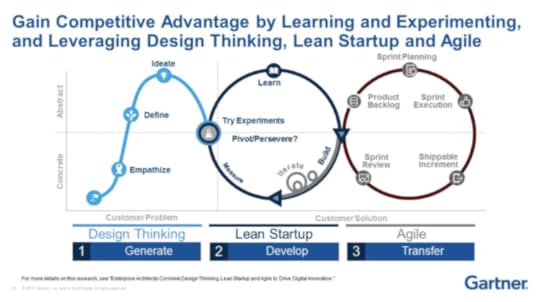
Gartner showed in a 2016 article on digital innovation a first articulation of how Design Thinking, LEAN startup and Agile could work together as a powerful problem-solving combination.
In hindsight it is easy to see how unrealistic expectations with Agile were, and often still are. How could the implementation of an Agile framework be the silver bullet to develop better software, build new products, acquire another company, transform the organisation, and manage your shopping list?
At Strategyzer, we always advise our clients against dogmatic and simplistic answers to the business challenges of the 21st century. Combining methodologies, such as Design Thinking + LEAN + Agile, to build a better product development process is certainly a step in the right direction. But it might not be sufficient to find the winning formula for product development in the digital age. Many large organisations still miss the most obvious reason why their Agile framework does not yet enable great product development.
Being ‘Agile’On a concrete, tangible but also superficial level, Agile is seen as a set of tools packaged in a framework, e.g. Scrum. Implementing an Agile framework in an organisation will lead teams to doing Agile without necessarily embracing the principles behind it. They are following the framework, but they are not necessarily being more agile.
More and more leaders want to achieve the Graal of “business agility”. In order to get there, one needs to do much more than just implementing a framework. This requires a completely new cultural operating system (OS). One that is based on empiricism (i.e. accepting uncertainty) and rigorously experimenting and discovering (rather than acting as if one can know and plan for everything upfront).

Only organisations and teams that embed these principles of empiricism, “inspect & adapt”, experimentation, continuous learning in their cultural DNA will develop business agility, and radically improve their product development capability.
Being agile + Strategyzer toolkit = the perfect fit
At Strategyzer we help entrepreneurs and product teams create products customers want. In Business Model Generation in 2009 and then Value Proposition Design in 2014, Strategyzer defined the process to go from a new business idea to a business and the tools (including the Value Proposition canvas and Business Model canvas) to support this process.
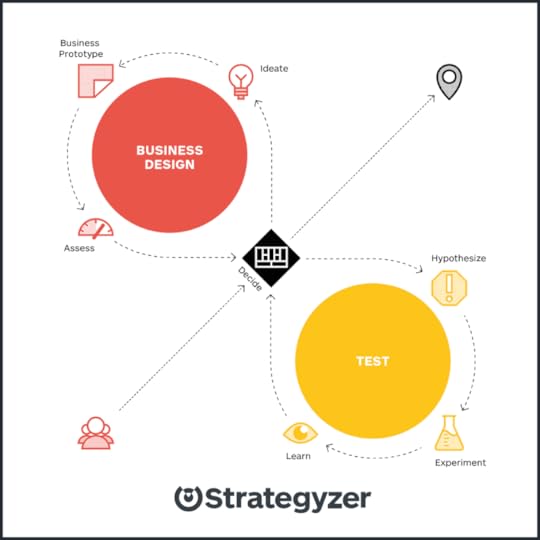 Source: Testing Business Ideas by Alex Osterwalder and David Bland
Source: Testing Business Ideas by Alex Osterwalder and David BlandWhen the product teams we work with have adopted an agile way of thinking and operating then the grounds are fertile for great product development work.
For business design, teams use the prototyping tools and design process outlined in Value Proposition Design. For testing they use the experiments library and testing process outlined in Testing Business Ideas. Together these tools help them go through many design-test loops until they’ve proven that their product actually fits customer needs. Only then can teams move on to building the product.
However, getting to product-market fit is an iterative and messy process. The iterative nature of this innovation work comes more naturally to teams used to Agile frameworks. And getting to product-market fit requires a total commitment from the team to the Agile principles of empiricism, experimentation, continuous learning.
Following an agile framework on its own is not enough, but agile principles and the Strategyzer toolkit are a powerful combination to build products customers want. And after a bit of meandering, that’s what I would answer the initial question.
Recap on key ideas on helping Agile teams build products customers want:
1. Implementing an Agile framework, e.g. Scrum, is not enough.
2. Embedding Agile principles of empiricism, “inspect & adapt”, experimentation, continuous learning is also necessary.
3. Blending Agile with other methodologies works.
4. Agile principles + Strategyzer Value Proposition Design & Testing Business Ideas = products customers want.
What are your key questions on innovation and business transformation?
This article was initially published on the Strategyzer blog

Executive question: How to help Agile teams create products customers actually want? was originally published in Notes from the innovation and transformation fields on Medium, where people are continuing the conversation by highlighting and responding to this story.
Executive question: How to manage an innovation funnel?
A short while ago, I had a coffee chat with the Chief Digital Officer of an ASX100 consumer goods company who is currently leading the digital transformation of a product-based company into the digital world.
She is constantly approached by “silver bullet solution vendors” and expressed her surprise at just how many charlatans there are in the field of business transformation. She resonated with the rigor that Strategyzer and I bring to the innovation practice, and was curious to learn more about how Global 500 companies efficiently feed and manage an innovation funnel, so we got chatting.
We started by discussing how managing an innovation funnel is different from managing a technology project portfolio, where the first key difference is uncertainty. In her digital transformation initiatives, I shared that ideas and projects could be placed on a spectrum from relatively low uncertainty (e.g. digitizing a paper process in existing operations) to high uncertainty (e.g. using available data to build completely new products and services).
Traditional methods involving the creation of a business plan and then execution of the plan work well on projects where uncertainty is low. But new business ideas with high uncertainty cannot be managed the same way and would need to adopt a portfolio approach.
The second difference is that managing an innovation portfolio is a volume game. It’s fundamentally different from managing the carefully curated and limited list of projects in a typical technology portfolio. To illustrate this point, I used data points from the venture capital world: if an entire industry loses money on two thirds of their investments, it is delusional to think that corporate executives could “pick the winners” from the start and successfully lead new business ideas all the way to market.
To create a new sustainable business, a company has to let a lot of ideas enter its innovation funnel and make small investments in them. In the chart we extrapolate on the VC data to show that a company whose objective is to create a new business with a 50x return would need to invest in 250 early-stage initiatives.
 Source: adapted from Correlation Ventures
Source: adapted from Correlation VenturesThe third difference is that managing an innovation portfolio requires killing the vast majority of ideas, initiatives and projects along the way. That’s not something leaders in large organizations are usually comfortable with.
On a typical technology project portfolio, once executives have approved a project, they expect it to go all the way to completion. Most leaders will use their power and influence to help the project team achieve project objectives. Yet managing an innovation portfolio requires sorting through a large volume of innovation options.
To do that efficiently, leaders should act like venture capitalists, doubling down on ideas, initiatives and projects that show promise while cutting off the ones that do not before they waste too much money and valuable resources.
A few cups of coffee later we moved on to discussing process, governance and funding.
Typical phases in an innovation project are discovery, validation and acceleration. How does that translate at the portfolio level? As seen earlier, discovery should enable the exploration of a large number of ideas. Validation should help reduce the uncertainty of new business ideas with solid testing. Acceleration should facilitate the rapid growth of tested business models with high potential. Other interesting characteristics at each phase can be found in the table below.
 Source: Testing Business Ideas by Alex Osterwalder and David Bland
Source: Testing Business Ideas by Alex Osterwalder and David BlandI spoke to her about how metered funding for teams can act as a powerful guard rail against too much waste in the innovation portfolio. It consists of providing just enough funding for teams to test the most critical hypotheses in the phase they are in, but no more.
We then talked about decision making. The common ‘kill ratio’ at each phase still came as a surprise to her: more than 80% of ideas explored in discovery should be killed in this phase. More than 80% of projects in validation phase should be killed in this phase. I clarified that this is not an absolute rule, but more of a useful guide to maintain a healthy portfolio.
As she was imagining herself making those decisions, we went through the three criteria that executives overseeing an innovation portfolio can base their decision on:
Strategic fit.Opportunity: the expected return of an initiative as visualized on the vertical axis of the Strategyzer portfolio map.Evidence: the evidence brought by the team (progress) as visualized on the horizontal axis of the portfolio map.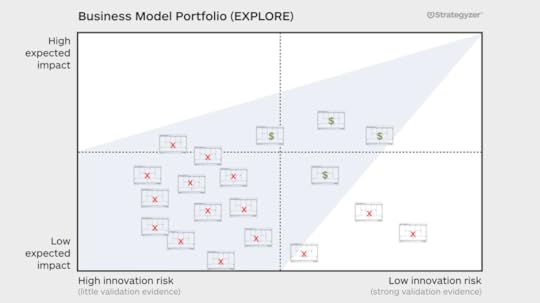 Source: Strategyzer
Source: StrategyzerWe discussed how the selection headache is actually resolved by the portfolio approach, as good ideas will emerge on the portfolio map and poorly performing teams will drop off.
At this stage of the conversation she asked me about concrete examples, so we discussed the high level actions taken by a global pharmaceutical company ($45bn+ revenues) that we work with at Strategyzer.
To feed their growth innovation portfolio, this company started with an intrapreneurship support program. Twice a year, they manage an application process where global intrapreneur teams can submit their new business ideas. Successful applicants enter a 3-month program to explore their business idea. The intrapreneurship support program is designed by the corporate innovation team to facilitate the discovery phase and includes metered funding, skills development and expert coaching.
More recently they added Strategyzer’s Spark offering as an additional way to feed their portfolio. (Spark is a virtual toolkit that guides teams through a 12-week innovation process at low cost.) And they included a bridge to the main intrapreneurship support program for successful teams.
Teams that survive the discovery phase can then access further funding and coaching. Strategyzer supports the validation phase for those teams with our innovation sprint that helps teams drastically reduce the uncertainty of their business ideas with 10 weeks of intense testing and high impact coaching.
After several iterations in the validation phase, a few successful teams should achieve a tested business model and be ready for acceleration. Even though this stage can seem closer to execution (a task that large organizations usually excel at) there are still critical obstacles to overcome.
Unfortunately, we had to slow down and stop our discussion at the critical point of acceleration, as we ran out of time. What a great place to pick up our next conversation though!
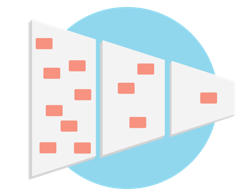
A quick recap on key ideas for feeding and managing an innovation funnel:
Manage ideas with high uncertainty with a portfolio approach.Play the volume game: make lots of small investments at the beginning!Kill the vast majority of ideas, initiatives, projects on your portfolio.Use metered funding.Make portfolio decisions based on strategic fit, opportunity and evidence.Enable discovery, validation and acceleration of new business ideas.What are your key questions on innovation and business transformation? Let me know in the comments.
This article was initially published on the Strategyzer blog. There are many resources available on the Strategyzer website (blog posts, books) if you want to go further on the topic of managing an innovation funnel.

Executive question: How to manage an innovation funnel? was originally published in Notes from the innovation and transformation fields on Medium, where people are continuing the conversation by highlighting and responding to this story.
Innovation coaching: Testing New Business Ideas the Owlet way
At Strategyzer we often use the Owlet team video from the International Business Model Competition in 2013 to illustrate how to de-risk new ideas, cheaply and quickly. Let’s unpack together the most important principles to follow when testing new business ideas.
When we train business teams on how to execute innovation sprints and show them the Owlet video (a pitch that led the Owlet team to win the International Business Model Competition in 2013) we start by apologizing to the audience. What could a group of innovation professionals like themselves with access to corporate knowledge and a wealth of resources really learn from inexperienced students? We tell them that they will probably not learn much, but we show the video anyway. Of course, this is a set-up as there is so much to learn in this 10 minute video!
In this post, I want to highlight key principles of testing new business ideas that are superbly illustrated by the Owlet video.
Trust the testing process, not your vision! Image: Co-founder Jake Colvin explaining how Owlet’s most critical hypothesis proved wrong and why they had to pivot their business model after one week of testing.
Image: Co-founder Jake Colvin explaining how Owlet’s most critical hypothesis proved wrong and why they had to pivot their business model after one week of testing.Success in innovation and entrepreneurship is based on solid testing. Notice how little time the Owlet team spends on selling their initial vision and business idea.
Instead, they focus on explaining how they de-risked their most critical hypotheses by running a number of experiments, getting solid evidence and insights and finally acting accordingly — even when it meant letting go of core aspects of their initial idea.
So, within the first couple of minutes, the Owlet case already illustrates two convictions of ours:
1. Don’t fall in love with your initial idea!
2. Innovation is a constant iteration between design and testing.
Test desirability first! Image: Colvin explaining why they tested market risk first before testing the technology risk
Image: Colvin explaining why they tested market risk first before testing the technology riskWhen you start testing your hypotheses, should you start with desirability hypotheses, feasibility hypotheses or viability hypotheses?
So many teams we work with are drawn to testing feasibility hypotheses first. We always strongly advise them against this.
You want to know why? Because so many startups and teams work on products nobody wants.
Innovation teams can avoid all the wasted time, resources and effort by applying one simple principle: start with testing desirability hypotheses!
If the tests show that your business idea has traction then keep going. But if no one wants your product or service then you have learned something valuable without having to spend much time, resources and effort.
By starting with market risk, i.e. desirability hypotheses, the Owlet team was able to learn within a week that their initial business idea — selling a wireless pulse oximetry device to hospitals — would never work and pivot their value proposition accordingly. In the course of 6 weeks they almost entirely de-risked the desirability of their business idea, even before building anything. Pretty impressive!
Here’s another blogpost on how to systematically reduce the risk of new business ideas, if you’d like to dive deeper.
Evidence trumps opinion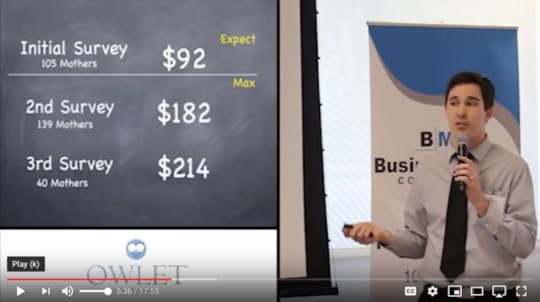 Image: Co-founder Kurt Workman explaining how pricing opinions coming from customer surveys proved very unreliable and how A/B pricing tests provided more solid evidence.
Image: Co-founder Kurt Workman explaining how pricing opinions coming from customer surveys proved very unreliable and how A/B pricing tests provided more solid evidence.Almost every innovation team we work with starts testing with customer interviews. While customer interviews are great for discovery, they are tricky for hypothesis-based testing. For a team with limited interviewing experience it is easy to go off track by mistaking opinions for facts.
Our constant coaching challenge in these situations is to push teams to go beyond interviews and select several experiments with a call-to-action. Only these type of experiments will give teams solid evidence on which to base their action.
“Be careful, what people say and what people do are two different things” we tell our teams, “don’t only do customer interviews”. They nod politely but it is hard to swallow, and they don’t really believe our advice to mistrust the data coming from customer interviews. Until we show them how Owlet tested the pricing of their product.
When asked for their opinion, people told the Owlet team they would expect to pay $92 for their product and would never spend more than $214.
But in pricing A/B tests, isn’t it interesting that the optimal price to maximise conversion proved to be $299? Much higher than any price the Owlet team had heard in customer surveys.
Their pricing tests demonstrate that “what people say and what people do are two different things”, and even shows us that it sometimes plays to your advantage.
You don’t need more time and money to test your business idea Image: Co-founder Kurt Workman summarising the time and money they spent to de-risk their business idea.
Image: Co-founder Kurt Workman summarising the time and money they spent to de-risk their business idea.After just 24 weeks and having spent $1150, the OWLET team had de-risked 2 business models enough for further investment. When I hear a team complain that they don’t have enough time or money for testing, I don’t argue but I invite them to watch the Owlet video again. “If a random team of students can de-risk their business idea in 24 weeks,” I tell them, “then there should be no reason why a team of professionals with access to so much more corporate resources couldn’t do it.”
Tell your story with the Business Model Canvas Image: Co-founder Jake Colvin using the business model canvas with images and color coding to share complex learnings in a simple way. Here the learning is that your user is not your customer.
Image: Co-founder Jake Colvin using the business model canvas with images and color coding to share complex learnings in a simple way. Here the learning is that your user is not your customer.If you watch the video, notice how easy it is to follow the story. The Owlet team uses the business model canvas to show how they de-risked the most critical hypotheses of their business idea and it just flows, even when they are sharing complex learnings.
Most teams we work with have the default temptation to build a fancy PowerPoint deck to impress their jury or investors. But we insist that evidence, not a fancy PowerPoint, is what matters most. And the Business Model Canvas is the obvious tool to tell the story and showcase the gathered evidence. If they need any convincing, we show them a typical “cognitive murder” pitch next to the Owlet video. They can put themselves in the shoes of decision-makers and decide for themselves which team they would invest in.
In my work with innovation teams, I also use Owlet to benchmark each team’s progress midway through an innovation sprint. Funny enough, I have not yet met a team able to make more progress in those first few weeks than Owlet. If I ever meet a team that can progress as fast as Owlet, I will have no other choice than to enrol them in the next International Business Model competition.
On a final note, let’s acknowledge that it takes time to build and scale a business as the Owlet story between 2013 and today shows. And that’s the last learning from this case.
The first few weeks are important of course, but there are many more weeks afterwards that are equally important in the long journey from idea to business. I wish you all the best in the next phases of your entrepreneurial journey.
This article was initially published as two posts on the Strategyzer blog. There are many resources available on the Strategyzer website (blog posts, online course, book) if you want to go further on the topic of testing business ideas.
* All images taken from the 2013 International Business Model Competition Owlet YouTube video

Innovation coaching: Testing New Business Ideas the Owlet way was originally published in Notes from the innovation and transformation fields on Medium, where people are continuing the conversation by highlighting and responding to this story.
July 31, 2019
Minute innovation learning: Do you always start with the customer?
We use the value proposition canvas to help innovation teams design products and services customers actually want. Although one question we get all the time (especially from new users of the value proposition canvas) is: Do you always start with the customer?
The last couple of decades have seen an overwhelming focus on customers. I have yet to advise a company whose vision or strategy doesn’t include an acute customer focus. And this plethora of customer-driven organisations rely more and more on methodologies such as Design Thinking which starts with an empathetic and exploratory approach toward the customer. But a good idea doesn’t have to become a dogma.
In this post we explain why you don’t always have to start with the customer, but you always have to end with the customer — especially the validation of fit between the customer (as mapped in your customer profile) and your product/service (as designed in your value map).
1 — Fishing for customer insightsThe innovation journey of many teams starts with a customer discovery process and a large number of customer interviews. In many corporate innovation programmes, it has become a design principle that teams cannot advance to the next stage of the programme and access more funding before having completed a large number of customer interviews, sometimes as high as 100 interviews in a 6–12 week window.
Why this focus on customer interviews?
There are many benefits to doing many customer interviews early in the innovation process:
Consistent customer feedback helps innovators to not fall in love with their initial ideas, and thus avoid one of the most dangerous pitfalls facing entrepreneurs.Customer interviews are the simplest form of testing innovators can do. When done properly, these interviews can provide early evidence on the most critical assumptions.After a while, these interviews will lead to a deeper customer understanding and to critical insights for designing a product or service that customers want.
The insights that innovators need to get from this discovery process are:
What are the most critical jobs, pains and gains of customers.And are any of these important enough that customers would be willing to pay for your product or service?When teams start their innovation process with just a business idea, the customer is a pretty good starting point. In this case, we coach teams to work on the circle — the customer profile — and map the critical jobs, pains and gains.
2 — Making the most of what’s availableMany of the teams we coach in large organisations have much more than just good ideas. These organisations might have key resources such as patents, capabilities or access to technologies that innovation teams can use to prototype new value propositions and business models.
A classic example of reusing an existing capability to build a new business model is Amazon with Amazon Web Services (AWS). Amazon leveraged its IT expertise and infrastructure, which was initially built for its e-commerce business, to create AWS — a suite of cloud computing services sold to enterprise customers.

The innovation journey is long and hard enough: it would be careless not to use all the assets and opportunities available to you. When we work with teams in large organisations we often help them prototype many different product and services using available assets early in their innovation process. In this case, we start our innovation process with the square — the value map — and we ask them “what new value proposition could you design based on this key resource?” This piece of technology? Or this capability? Or this patent? And they describe how those available assets could contribute to a potential value proposition using the value map.
In both instances, whether you start with the customer to identify critical customer insights or start prototyping a new value proposition built on an existing key resource, you will soon need to go through a solid testing process to validate the fit between your value proposition and the customer segment.
That’s why we always remind innovation teams that we work with that you don’t always have to start with the customer, but if you want to achieve fit, you have to end with the customer.
Why not come and join us at one of our global Masterclasses to learn about more value proposition design best practices for you to apply to your own business?
Note: this post was originally published on the Strategyzer blog and is only a small insight into the awesome work done by Greg Bernarda on Value Proposition Design best practices.

Minute innovation learning: Do you always start with the customer? was originally published in Notes from the innovation and transformation fields on Medium, where people are continuing the conversation by highlighting and responding to this story.



